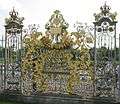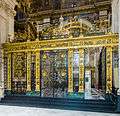Jean Tijou
Jean Tijou was a French Huguenot ironworker. He is known solely through his work in England, where he worked on several of the key English Baroque buildings. Very little is known of him biographically . He arrived in England in c.1689 and enjoyed the patronage of William III and Mary II [1]. He left England for the continent c.1712[2] He was father-in-law to Louis Laguerre who married in St Martin-in-the-Fields[1].

His major commissions include making gates and railings for Hampton Court Palace, where he worked between 1689 and 1700[3], he was paid £2,160 2s 0.25d for the wrought iron screens at Hampton Court[4], he also is known to have worked at Kensington Palace. He produced the screens and grilles of St. Paul's Cathedral for Sir Christopher Wren, and worked at country houses such as Easton Neston, Burghley and Chatsworth. At Chatsworth his surviving works include the balustrade of the upper flight of the grand staircase and the set of gates known as the Golden Gates, which were moved to their present location at the north entrance to the park in the 19th century.
Little else is known of the man, Jean Tijou, other than he was a master metalworker. Tijou elevated blacksmithing to an art with his lavish baroque sheet metal overlay on iron structures. To achieve this style of artistry, sheet metal is hammered from the rear of the plate to create form and then used to cover fire welds on foundational iron structures such as gates, hinges, fence work or wall deco pieces.
Some of works by Tijou were gold plated to add to aesthetics. It is possible that a rendering of Jean Tijou appears in a book which he designed entitled A New Book of Drawings Invented and Desined [sic] by John Tijou[2], in 1693. His book was engraved by a famous artisan himself, Michiel van der Gucht. The possible rendering of Tijou appears at the bottom of the page. The book is currently housed by the Smithsonian in the Cooper Hewitt Collection in New York City.
Gallery of Work
.jpg) Golden Gates, Kensington Palace, late 17th century, attributed to Tijou
Golden Gates, Kensington Palace, late 17th century, attributed to Tijou General View of screens at Hampton Court Palace, c.1700
General View of screens at Hampton Court Palace, c.1700 Hampton Court Palace, screen representing England, c.1700
Hampton Court Palace, screen representing England, c.1700 Hampton Court Palace, screen representing Scotland c.1700
Hampton Court Palace, screen representing Scotland c.1700 Hampton Court Palace, screen representing Ireland c.1700
Hampton Court Palace, screen representing Ireland c.1700 Hampton Court Palace, screen
Hampton Court Palace, screen Gates in St. Paul's Cathedral , London
Gates in St. Paul's Cathedral , London Burghley House, entrance, with Tijou's 'Golden Gates' at the base
Burghley House, entrance, with Tijou's 'Golden Gates' at the base Burghley House, with Tijou's 'Golden Gates' in background
Burghley House, with Tijou's 'Golden Gates' in background Balustrade of King's Staircase Hampton Court Palace c.1695
Balustrade of King's Staircase Hampton Court Palace c.1695
References
- Lister, p. 92.
- Lister, p. 93.
- Harris, p. 4.
- Lister, p. 94.
- John Harris (1960). English Decorative Ironwork from Contemporary Source Books 1610-1836. London: Alec Tiranti Ltd. OCLC 30213283.
- Raymond Lister (1957). Decorative Wrought Ironwork in Great Britain. London: Alec Tiranti Ltd. OCLC 1046341139.
.
External links
- An illustrated page about Tijou's work at St Paul's Cathedral
- Cooper Hewitt, Smithsonian Design Museum. "Album, New Book of Drawings". Smithsonian Institution. Retrieved 15 May 2017.